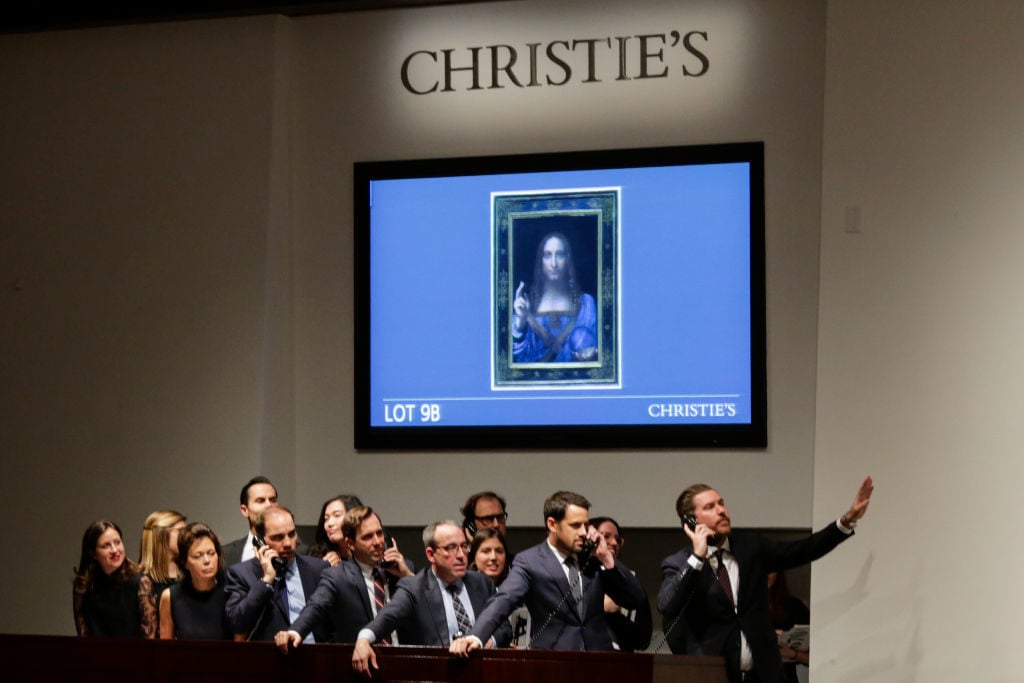Market
Saudi Arabia’s US Embassy Chimes In on the Fate of Leonardo’s ‘Salvator Mundi’
Regardless of who bought it, the $450 million painting is definitely heading to the Louvre Abu Dhabi.

Regardless of who bought it, the $450 million painting is definitely heading to the Louvre Abu Dhabi.

Julia Halperin

Is the mystery of who bought Salvator Mundi slowly coming into focus?
International media reports now claim that a Saudi prince bought the painting on behalf of the Abu Dhabi Tourism and Culture Authority (TDIC), the government agency that runs the Louvre Abu Dhabi. The $1 billion museum opened last month and will soon be home to the Leonardo da Vinci painting, which became the most expensive artwork ever sold when it fetched $450.3 million at Christie’s last month.
The question of who actually bought the work—and for whom—has played out in multiple languages in international newspapers and on Twitter over the past few days. Indeed, the way that this major piece of news has unfolded as a bizarre series of leaks, denials, rumors, and counter-rumors has become its own narrative.
In the latest development, the US embassy in Saudi Arabia released a statement on its website confirming that Prince Bader bin Abdullah bin Mohammed, “a friendly supporter of the Louvre Abu Dhabi,” was indeed the buyer of the painting. (The New York Times had identified the little-known Saudi prince as the buyer on Tuesday.)
According to the embassy’s statement, Prince Bader bought the painting on behalf of the TDIC. “The prince attended [the Louvre Abu Dhabi’s] opening ceremony on November 8th and was subsequently asked by the Abu Dhabi Department of Culture and Tourism to act as an intermediary purchaser for the piece,” the statement says.
Reuters reportedly obtained a document that authorized Prince Bader to purchase the painting on behalf of the TDIC for a hammer price of up to $500 million. (For the record, that would have put the final price tag for Salvator Mundi at an eye-watering $562.5 million with the buyer’s premium.)
The embassy’s statement that Prince Bader was an intermediary in the TDIC’s purchase is consistent with a statement that Prince Bader himself released on Wednesday. In it, he disputes some facts in the Times original story but did not deny that he bought the painting.
Prince Bader writes (translation from Arabic courtesy of the Rothkopf Group):
Prince Badr bin Abdullah al-Farhan al-Saud, surprised by the New York Times allegations attributed to him, describes them as inaccurate.
Prince Badr bin Abdullah said, “I read with great surprise the report that was published in the New York Times, as it contained a lot of surprising and inaccurate information.
Prince Badr bin Abdullah also confirmed that, “I did not intend to respond on my behalf and on behalf of citizens to the positions of a newspaper hostile to everything that is Saudi and its dissemination of strange rumors.” “If it were not for the encouragement of friends and loved ones, I would not have made this statement.”
This new information still leaves some questions unanswered, however. It does not address the reported involvement of Saudi Arabia’s crown prince Mohammed Bin Salman, who the Wall Street Journal said yesterday was the real force behind Prince Bader’s purchase. A Saudi government official denied this to Reuters.
Why would Abu Dhabi’s TDIC enlist a Saudi prince to buy the world’s most expensive painting on its behalf? The fact that two men ran into one another at the opening of the Louvre Abu Dhabi, a week before the landmark sale, does not exactly seem like a compelling explanation.
And inconsistencies in published reports remain. The FT claims that the painting was indeed paid for by the Saudi Arabian government—and then given as a gift to the UAE as a token of the growing diplomatic ties between the two countries. A source told the FT: “It is supposed to be a state to state gift, like when France gave the Statue of Liberty to the US.”
In a new story today, the WSJ doubled down on its own reporting, maintaining that Prince Mohammed paid for the work and gave it as a gift to the UAE.
A spokesperson for the Louvre Abu Dhabi has not returned a request for comment.